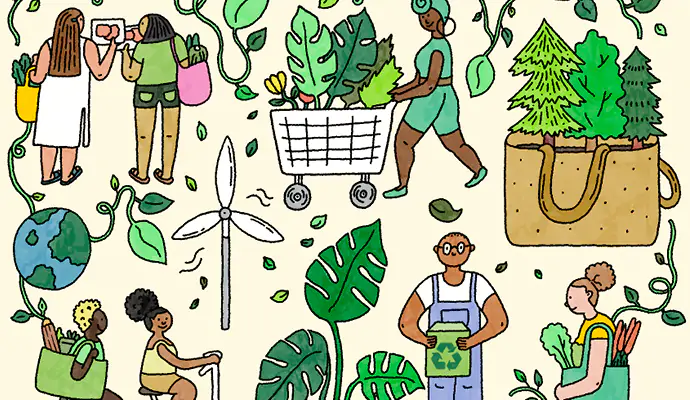Everyday products, from personal care to household essentials, carry hidden environmental costs. Recognising and addressing this impact through the sustainable switch is vital for our planet’s health. This guide explores the ecological footprint of common items and how choosing sustainable alternatives can foster a healthier, greener future for all.The True Cost of Common ProductsThe true cost of common products extends far beyond their price tags, encompassing a significant environmental toll. From the extraction of raw materials to manufacturing processes, transportation, and eventual disposal, everyday items like plastic packaging, fast fashion, and electronic gadgets contribute to resource depletion, pollution, and greenhouse gas emissions. The widespread use of non-biodegradable materials, such as plastics, leads to alarming levels of pollution, particularly in our oceans, affecting marine life and ecosystems. The fast fashion industry is notorious for its water consumption and chemical runoff, posing serious threats to water quality and biodiversity. Electronic waste, another growing concern, releases toxic substances into the environment when improperly disposed of. These hidden costs highlight the urgent need for a shift towards more sustainable consumption patterns, prompting consumers to consider the long-term environmental impact of their product choices.Understanding the Sustainable AlternativeUnderstanding the sustainable alternative involves recognising products designed with environmental and ethical considerations at their core. Sustainable products are typically made from natural, renewable, or recycled materials that minimise harm to the planet. They are produced through processes that conserve energy, reduce water usage, and limit chemical pollutants, aiming to lower carbon footprints and protect ecosystems. Ethical labor practices are also a hallmark of sustainable products, ensuring fair wages and safe working conditions for all involved in the production process. From biodegradable packaging to organic ingredients in personal care items and clothing made from sustainable fibers like hemp or organic cotton, these alternatives offer a way to meet our needs without compromising the well-being of future generations. Embracing sustainable products reflects a conscious choice to support practices that prioritise the health of the environment and society, illustrating a commitment to a more sustainable and equitable world.Benefits of the Sustainable SwitchSwitching to sustainable products offers numerous benefits that positively impact the environment, economy, and personal health:
● Environmental Conservation:● Reduces waste and pollution by minimising the use of non-biodegradable materials.● Conserves natural resources through the use of renewable materials and energy-efficient production processes.● Economic Advantages:● Encourages the growth of green industries and job creation in sustainable sectors.● Reduces long-term costs for consumers through durable and energy-saving products.● Health and Safety:● Decreases exposure to harmful chemicals found in many conventional products.● Improves indoor air quality and overall well-being by using natural and non-toxic materials.● Social Impact:● Supports fair labor practices and ethical sourcing, promoting social equity.● Empowers communities by fostering local and sustainable businesses.How to Make the Sustainable SwitchMaking the sustainable switch involves thoughtful consideration of your consumption habits and a willingness to embrace eco-friendly alternatives. Start by evaluating your most frequently used products and identifying sustainable replacements, such as switching from single-use plastics to reusable options. Educate yourself on the environmental impacts of different materials and production processes to make informed choices. Look for products with certifications like Fair Trade, Organic, or Energy Star, which indicate adherence to sustainable practices. Consider the lifecycle of items, preferring those that are durable, repairable, and recyclable. Support brands and businesses that prioritise sustainability in their operations and supply chain. Remember, the transition doesn’t need to happen overnight. Begin with small changes and gradually incorporate more sustainable practices into your lifestyle. By making the switch, you contribute to a larger movement towards environmental stewardship and a healthier planet.Challenges and How to Overcome ThemAdopting a sustainable lifestyle presents challenges, but with determination and resourcefulness, these can be overcome:
● Cost Concerns:● Sustainable products may have higher upfront costs. Overcoming this involves viewing purchases as long-term investments in quality and environmental savings.● Limited Availability:● Some regions may have fewer eco-friendly options. Online marketplaces and local farmers’ markets can offer wider selections of sustainable goods.● Knowledge Gaps:● Understanding what truly constitutes sustainability requires education. Utilise online resources, documentaries, and books to broaden your knowledge.● Convenience:● Eco-friendly choices often require extra effort. Planning and preparation, such as carrying reusable bags and containers, can become second nature over time.● Resistance from Peers: ● Facing skepticism from others can be disheartening. Lead by example and share the benefits and reasons behind your choices, potentially inspiring change in others.
Each challenge in adopting a sustainable lifestyle is surmountable with the right mindset and strategies. Persistence and willingness to adapt can pave the way for a more sustainable and fulfilling way of living.The Future of Sustainability in ProductsThe future of sustainability in products is marked by innovation and a deeper integration of eco-conscious practices across industries. As consumer demand for sustainable products continues to grow, companies are increasingly prioritising green materials, renewable energy sources, and circular economy models to reduce waste. Technological advancements will further enhance the efficiency and accessibility of sustainable products, making them the norm rather than the exception. This shift towards sustainability not only reflects a collective effort to mitigate environmental impact but also represents a significant step towards achieving global sustainability goals, ensuring a healthier planet for future generations.Thank you for reading we hope this article has been beneficial to you!
